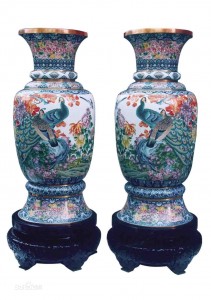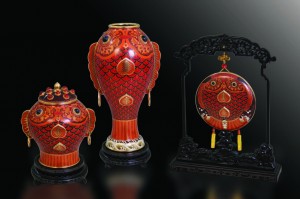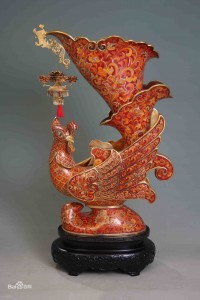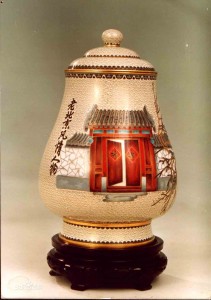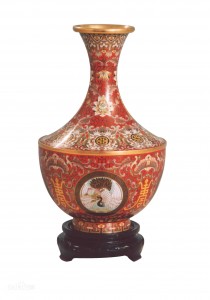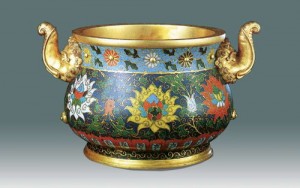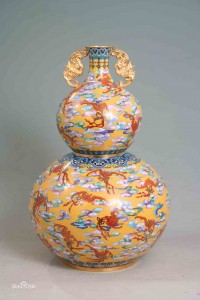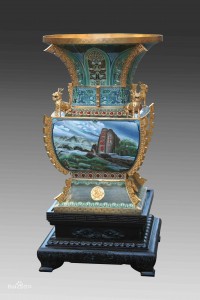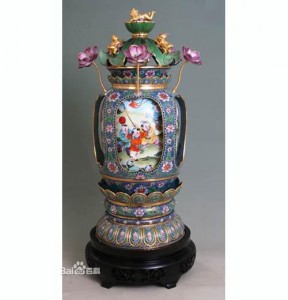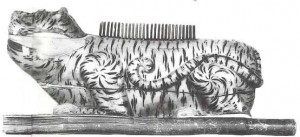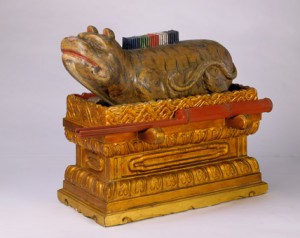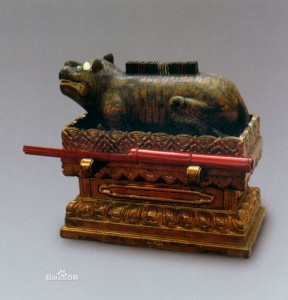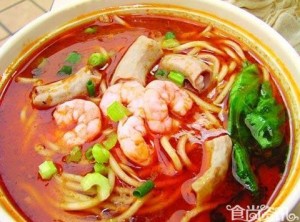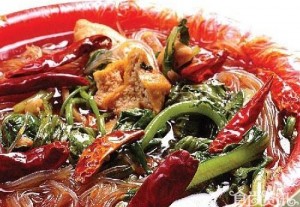Technology definitions
Copper cloisonné enamel; burning blue
Embedded in the metal wire and then applied on fetal enamel art enamel. Began in the Ming Dynasty of China’s famous special crafts. Applied science:
Materials Science and Technology (a subject); inorganic nonmetallic materials (two subjects); inorganic coatings (two subjects)
Cloisonne
Cloisonne industry as the country’s leading enterprises, 1963 Beijing Enamel Factory prepared the “Cloisonne procedures” and “process quality standards”, the same year in June released by the China Light Industry Association implemented the “People’s Republic of cloisonne handicraft industry standards . ” Since then, cloisonne industry a unified product quality standards, making cloisonne production gradually scientific management.
Over the years, enamel factory with its product development strengths, superior quality and strong cultural and artistic taste of renowned domestic and foreign markets, and the formation of well-known “Beijing enamel” and other brands, is recognized as a continuous Beijing Famous Brand. Enterprise has trained national and municipal arts and crafts masters, senior artists, technologists, engineers, senior technicians and other professional and technical personnel, the formation of an excellent design, excellent production and professional management team, corporate brought together within the industry, two-thirds of the country cloisonne national masters and senior technicians. Strong technical strength, so that Beijing Cloisonne enamel brand excellence in the Ming and Qing dynasties inherited traditional techniques based on a leap of development. Greatly enriched the product shape, pattern, color, process quality, artistic merit than any one historical period, leading the nation cloisonne art direction and trends, represent the contemporary development of cloisonne highest level. At home and abroad cloisonne lovers, collectors loved and industry praise.
Legend
Folklore, the Yuan Dynasty, the palace fire, throne room, and all the treasures burned to ashes. But the ruins of a more colorful sparkling crystal vase. Ministers surprised, dedicated to the emperor, saying it was the gift of God. The emperor got this thing put it down, pass under a decree immediately mobilize all capital craftsmen, deadline March imitation, failing that, all beheaded. Decree what may be too busy capital in ninety-nine eighty-one craftsmen hand-Square. Everyone baffled, can not fathom what God has given this process. Finally only turn to the capital first artisan “skilled Lee”, the legend he is a Goddess posterity, because being good cunning craft, was hailed as a “skilled Lee.” Soon, “skilled Lee,” said Xia Yi Nvwaniangniang wearing, foot clouds to his tomb says: “Aquarius flower shine, depends on skilled planted the flowers, not Baiji flowers do not open, butterfly difficult without gossip come from flooding stone pain, how can I stay too often in the spring. “” skilled Lee “fathom this dream, the original palace fire, throne room, where gold and silver jewel pillow melting together to form this bottle. And under the decree, regardless of “clever inventions” made many Aquarius, are owned by the palace all, because this is the palace treasures out a big fire, so people call it “odd treasure burn.” Because ordinary people not qualified to have a “Keebler burn”, so this art has become a court art. To the Ming Jingtai years, the level of technology to reach its peak. As the product has mostly peacock blue-based, so people put this craft called cloisonne. Later, this name has been in use ever since.
Today, cloisonne has not only deserve to have only the emperor objects. But because of its exquisite, known as “a cloisonne, ten the kiln.” 1904 Chicago World Expo, China cloisonne won the first prize. Now, cloisonne in Wuzhou universal reputation earthquake, loved by the people of all countries and praised.
History
Overview
Cloisonne also called “Copper cloisonné enamel”, Beijing is famous traditional handicraft. Because of its prevalence in the Ming Dynasty Jingtai years, production techniques more mature. “Copper cloisonné enamel” products, has been the consensus of many scholars.
Cloisonne, also known as “Copper cloisonné enamel”, which is a special handicraft, is made with a fine flat copper wire lines, in copper Niechu a variety of patterns on the tire tread, and then fill in the pattern multicolored enamel points within , after firing, polished gold-plated made. Appearance of crystal moist, colorful.
About cloisonne origin, archeology has been no uniform answer. A view that was born in the Tang Dynasty cloisonne; Another argument is that when the Yuan Dynasty Kublai expedition from West Asia, the Arab area pass into China, the first area in Yunnan popular favorite person obtained after the capital, only into the Central Plains. But one thing is academic community recognized: Ming Xuande years is China cloisonne production process advantages, and reached a new peak, “cloisonne” also was born. Glaze are fat, rough silk workers, Microhyla abundant.
Beijing is the birthplace of Chinese cloisonne, is the most important place of origin. Beijing Cloisonne forceful styling with elegant, complex rich patterns, elegant colors solemn known, gives a mellow sound, delicate neat, magnificent, blossoming artistic feeling, became world famous traditional handicrafts. Cloisonne art features available shape, pattern, color, light four words to summarize. An exquisite cloisonne ware, first of all have a good shape, depending on the system tire; also have beautiful decorative patterns, depending on the filigree; gorgeous blue color depends on the material preparation; brilliant gloss finish on polished and gilded. So, it is a fine art, craft, sculpture, mosaic, glass melting, metallurgical expertise as a whole, with a distinctive national style and profound cultural connotation, is the most one of Beijing characteristics of traditional handicrafts.

Late Yuan Dynasty
Accordingly, China has emerged late Yuan Dynasty cloisonne products, should be the logical thing, and National Palace Museum collection of animal ears ring bottles, hook Lin Ding furnace, furnace Lotus elephant ears, etc., should be of the late Yuan Dynasty works. In “Song of foreign Biography” records: “big food country” of the Persian nickname. “Great food”, the Song and Yuan Dynasties Chinese title against Valencia in the Arab region. According to historical analysis of relevant experts in this case, the firing of the “big food Kiln” Arab craftsmen with firing technology and raw materials to China.
Chinese have a very philosophical saying, “Stones from other hills may serve to polish jade”, even if such tires filled with metal cladding baked enamel glaze works are exotic, but in the profound Chinese art of soil , was soon a unique blend of the traditional Chinese style, the history of Chinese arts and crafts become a bright pearl.
“Cloisonne” This title was first seen at the Palace Office Department files. Qing six years (1728) “at work in each made clear file” reads: “In early May the 5th, according to the Yuanmingyuan stickers stating, June 4, 1998, Prince Yi Hai doctor was looking into the manual labor, the throne: …… enamel Bottle gourd-style jacket pattern Qunxian birthday, flower baskets Chunsheng also tacky. Begonia style enamel pots this year and then a small, Queling bad, and the other to do its imitation cloisonne enamel vases bad. Chin this. “This record, the imitation Period cloisonne enamel products called “cloisonne enamel”, which is currently seen in “cloisonne” appellation of the earliest written records.
Xuande years
Cloisonne seen in kind to Xuande years (1426 ~ 1435) the most. During this period, craft style characteristics has been formed, skilled, approaching maturity period. Varieties of bottles, plates, bowls, stove, round box, aromatherapy and so on. Then came the tripod and the like enjoy the goods. Tire type of the material making materials gold, copper, two kinds. Patterns are mostly banana leaves, gluttonous, lion play ball, passionfruit and Ming dynasty lotus. Mostly glaze azure (light blue), sapphire blue (lapis-colored), light green (grass green), dark green (jade green vegetables), red (Bloodstone color), white (car Drainage color) and yellow. Palace Museum Xuande years of Indian lotus bowl, flower-shaped plump, bright colors, enamel solid, representative works of this period.
Jingtai years cloisonne products on display from the Forbidden City and other places over the physical point of view, technology has been greater development. Palace of the Queen’s prison (Royal Factory Square) has made cloisonne workshop (“old news the next test”). During this period the system has reached a considerable tire height. Fetal-type well and there is a round to the practical aspects of transformation. In addition to bottles, plates, bowls, boxes, smoked, oven, tripod, there are flowers, pots, basins, brazier, lamps, candlesticks, bottles, pots and other artifacts, there are dragons playing with a pearl, Kuilong Kui phoenix auspicious theme, there Yunhe, flames and other manifestations of Taoism, Buddhism content theme. Ming dynasty lotus patterns are becoming increasingly plump, lively and there are many levels dendrite shape, glaze also appeared grape purple (amethyst color), Turquoise Blue (sky blue, sapphire blue pastel color) and purple (pink) new color, this time with a glaze connotation of brightness and purity, the light emitted by gemstones. At any later time did not reach this level. In the decorative techniques, and attaches great importance to metalworking process. Artifacts of the top cover, ears, feet and other parts sideline, live more than a chisel decoration. Mr. Zhu Jiajin said that during this period the system?; Filigree; neat; polished; Xirun; gilded; uniform solid “,” on the basis of age in Xuande another step to improve. “(” Heritage “in 1960 the first phase).
Ming Dynasty cloisonne shape mostly vessels, the majority of ancient ceramics and bronzes traditional style. Its decorative patterns in Ming dynasty lotus-based, there are a few series deformation patterns of flowers and decorative bronze, its color with two blue (sky blue) primary colors, together with a small amount of red, white, green, yellow and other colors. Color uniform, stress, decent decor, decorative copper live sleek, thick combination and focused. Cloisonne mature North, with its colorful, rich ethnic flavor of artistic styles and famous.
Qing
Qing Dynasty cloisonne enamel process is the development of another period. Due to social stability and economic prosperity, the establishment of Queen’s Palace Hall of Mental Cultivation factory called “Office was.” Kangxi three years (1691), “Office was” the Queen artisans to hundreds of people. Kangxi three years (1693), set up a “work” to create a variety of Queen’s artifacts. Enamel for one of them. But this level of production compared to the Ming period no major development. To the Qianlong period (1736 ~ 1796) Cloisonne and lacquered, gilded mosaics and other industries, has been an unprecedented development. Qianlong four years, from Guangzhou to provoke enamel artist Liangshao Wen, Yangzhou artists invited to the palace Wang Shixiong produced enamel. During this period, cloisonne products everywhere in the palace. Small bed using the account hook, large screens, and even high flush with floor pagoda (National Palace Museum Treasures Qianlong garden Temples Alhambra palace hall has a small display), as well as daily necessities, furniture, couch, wine, ink, cartridges, penholder, architectural, religious articles, etc., nothing is prepared.
This period of physical materials used in the upper, middle and lower third-class, high-quality tires gold by gold, silver medium by silver tires, tire wire copper inferior persons “(” Peking enamel Industry Update “, 1928). content pattern broader than the Ming Dynasty. Cordyceps pattern more vivid and colorful birds, dragon and phoenix patterns more significant hardness and softness, Ming Lin has also evolved into a beautiful lotus fine show hook, and the emergence of the use of literati paintings pinch system works, which have already started using hand pressure wire machine, make silk workers reached an unprecedented feat beautifully proportioned. glazes not only appeared pink, silver, yellow, and black and other colors, and grinding technology has been greatly improved. glaze grinding refinement , to the point Run technology to improve the performance of the work force and played an important role in product trachoma is also greatly reduced. cloisonné and lacquer, a combination of wood and other craft, but also began Qianlong. early Qianlong cloisonne basically maintained the style of the period, but has started to decline, until Daoguang period (1821 ~ 1851), the remains of a small number of works.
After the outbreak of the Opium War of 1840, with a distinctive national style copper cloisonné enamels once favored by Westerners, enamel process with a slight recovery and development. Xianfeng years, there Dexing into, GSK Cheng, Shui Tang and several, well-researched enamel an industry, the beginning and the burgeoning “(” Peking enamel industrial Recent “,” Economic Monthly “July 1928). Guangxu two sixteen years (1900), Boxer Rebellion scored Beijing, Boycott wide open, cloisonne exported to foreign countries in which foreign trade and economic stimulus, in addition to government-run enamel workshop, the people also have opened trade names and stores, such as God Lee, Baohua students, Jing Yuan Tang, Tang Zhiyuan, etc. In 1904, Heaven Lee production of “Bonding furnace” Chicago World’s Fair in the United States won the first prize (and later in the 1915 Panama Pacific International Exposition again won first prize), in the international reputation has been boosted, countries have to compete for orders, there boom. Domestically, the period of time after the mid Xianfeng, Beijing Cloisonne only one place you can buy because of the traffic inconvenience, and there are other towns businessmen to Beijing to buy, so few sales. late Qing Dynasty, enamel (cloisonne) products showing a more prosperous, although once the scene, but this situation is short-lived, and soon entered a recession predicament.
The early Qing Dynasty cloisonne lack of originality, regardless of shape, color and decoration mostly followed the Ming Dynasty style. In the late Qing Dynasty, the royal palace of luxury, a great impact on the cloisonne, rich styling works of this period, in addition to the vessels but also have a three-dimensional modeling of buildings, screens, tables, chairs, and practical things such as animal shapes. Can be said that the mid-Qing Dynasty, cloisonne in the performance of content, embarked on a new era. Its decorative wide range of topics, such as hook lotus, dragon, flowers, birds and other auspicious patterns, colors are more enriched the Ming Dynasty. Qing Dynasty cloisonne development plays a big role. Since cloisonne mostly in the middle of the Qing court before the worship, so its shape, decoration, color and workmanship, the overall feeling is too cumbersome, too extravagant.
1911 to 1933, the industry is basically in cloisonne hovering state of development. The early Republic, in the domestic market, hookahs like it supplies great sales. Meanwhile, the United States, Britain, France and other countries set up in Peking Matheson businessmen, eager to buy cloisonne. Located in Wangfujing Street Gerard companies is designed for foreigners cloisonne collection agency. 1923 ~ 1924 Peking cloisonne SECTOR boom, God only benefit an annual turnover reached 15 million None, hired more than 350 people, and often employ casual workers. Factory located in Bao Temple Street, Ma Lixin Street has its sales outlets, Shanghai, Hankou and distribution outlets. Thus cloisonne industry developments at the time. In terms of exporting, according to the Customs was published “China Import and Export Trade Statistics Monthly” and “calendar customs reporting” provides material point of view, cloisonne exports goes wandering down trend.
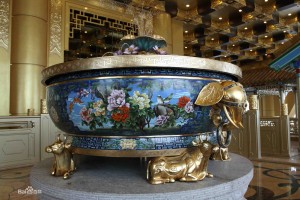
After the founding of New China
Heritage Protection After the founding of the PRC, cloisonne artists and cultural and artistic accomplishment has been greatly improved, especially since the 1960s, professional and technical personnel and constantly enrich and effectively improve the overall quality of the team of practitioners. Cloisonne industry and attracting serious inherited the traditional cloisonne modeling prudent rich pattern plump, bright, silk works fine strengths, restored stove, tripod, pots, three-dimensional animals, candlesticks, and in the past that the most beautiful yet hardest six flap bottles, vase, Begonia bottles of traditional products. This new attempt to get good results, while maintaining the original quaintness of the wind, but also enrich the cloisonne varieties. In 1959, to celebrate the tenth anniversary of the founding of the PRC, designers and artists created for the Great Hall of the new “big fish tank goldfish lotus” style deep funky, patterns lively, full of fun. Designed in the 1970s produced a large rare in history “Lion stove”, “pavilion stove”, “lion Gun Xiuqiu market”, “peacock pot” and other products.
According to “applicable, economic, aesthetic” principle, continue towards Cloisonne decorative and practical combination of direction, creating a variety of smoking, stationery, lamps, tea, chopsticks holder, business card case, jewelry boxes, flavored with electronic clock, wall hangings, table and stool, screens, trophies and other products, novel appearance, there is a strong national style. In addition, there are many themes reflect real life of good works, such as: fresh and warm, “Plum insert disk” romanticism “steel vase” and “Yan’an bottle”, “the capital of Eight” and so on, for numerous to cite only the rich flavor of the times, but also has a high degree of ideological and artistic. Number of products increased more than hundreds of times before the founding of the PRC, reached more than 1000 kinds of varieties and specifications, and the quality improved significantly, sold in hundreds of countries on five continents and regions. Cloisonne is also frequently state departments as precious gifts to dignitaries from various countries, enhance international exchanges and solidarity. China’s first session of the National Games and Afro-Asian, African and Latin cloisonne table tennis tournament have chosen to do trophies, famous for its ancient artistic value reflects the winner’s honor.
June 5, 1997, by the Beijing Enamel Factory Design’s “celebrate” on the bottles, each 1.8 meters high, the maximum diameter of 0.8 meters and weighs 192 kilograms, the Beijing Municipal Government as a gift presented to the Special Administrative Region of China, held a solemn departure ceremony.
April 1998, a city 850 anniversary of Moscow, Beijing Enamel Factory production of a pair of cloisonne big bottle, was chosen as a gift to the Beijing municipal government of Moscow congratulations. 2005, cloisonne craft masters resurrected cast tire technology, produced from the Buddhist scriptures in combination with eight works of “Buddha treasure Dragon”, each statue height 48 cm, diameter 18 cm, a total of more than 50 figure. This is a cast bronze cloisonne poured tire tread shape, and then filigree, filling glaze, bluing, gilt, showing a stocky, thick, gas-complex features.
Tire manufacturing processes over the past cloisonne worker with a hammer will completely rely on a variety of tire-shaped copper Zacheng, inefficient, labor-intensive manufactured products are often not specifications. In 1958, Beijing Enamel Factory Workers for trial of cloisonne trundle bed (also known as “rolling bed”), and through continuous research and improvement, from the beginning you can only roll the vial to roll big bottle, so that the whole system tire greatly increased the productivity of processes. As can curling machine-made tires, a system of regular blank form not only Zhou Zheng, and because the interface flux reduction, bottle black seam is reduced, improving product quality. In the past have finished burning blisters, pores, clear brush later added carcass process with sulfuric acid to remove impurities on the body, and then into the next process, this small technological change, basically eliminated trachoma and stomatal . The late 1990s, filigree process of self-developed system utility workers to children machines and bladder wire machine, some of the usual dosage is large and also partially normalized silk workers to achieve a semi-mechanized, and some clouds head pattern, plum head , peach, lotus hook, character codes, but also to switch to mold making. Point blue instead squeeze tube method, so that part of the point of blue patterns efficiency, quality assured. Glazes with electric ball mill, grinding glaze only saving hours of work have a more subtle. Welding coal stove since the early 1970s have been gradually furnace, liquefied petroleum gas furnace replaced in 2003, Beijing Enamel Factory through technological innovation to spend that environmentally friendly and energy-saving natural gas welding activities. To solve the historical “ten blue nine sand” serious chronic problem affecting product quality. Cloisonne polishing process has been used for centuries human grinder, in the 1950s, Beijing Enamel Factory modification of the human grinder with electric drive, making this procedure polishing machine Jie oriented towards half. And later in Beijing Fifth Design Institute with the assistance of a successful trial of the electric grinder. Through continuous improvement and polish with a cloth wheel, making cloisonne products meet the “flat, sharp, light, smooth, bright”, more than any time in history the quality is good, until modern times, cloisonne really come into the market, it is already known works of art.
Status
Cloisonne was born in the palace, the royal important component of the main palace hall furnishings, the house is also a town treasure. Majestic Forbidden City palace, or a circlet Imperial Palace, the Summer Palace Pai Yundian, etc. In the case of these imperial palace statue, cloisonne jewel-like light Mans is always impressive.
Historical records: Qianlong forty four New Year’s Eve dinner, dinnerware is the only Emperor Qianlong cloisonne, underneath all with porcelain. Visible in the history of China cloisonne plays what role, she is a symbol of identity and status. Since cloisonne historical significance and technology, 2006 was listed as the first batch of intangible cultural heritage, Taihe Square Cloisonne is worth appreciation, collection, gift of the best works of art treasures.
Characteristic
Cloisonne with lacquer, jade, ivory is called Beijing’s four most famous crafts, arts and crafts world, she is a bright pearl. Cloisonne its long history, elegant and graceful styling, vibrant colors, ornate and colorful patterns, the number of varieties styling, this site is exactly what I marvel of her incomparable artistic charm and dazzling artistic image. We are willing to cloisonne ancient art that are unique to contribute to the healthy development.
Cloisonne as an arts and crafts, and its system of law that is in bronze with colored enamel on the surface of painted pattern, the pattern of four weeks embedded with copper or gold and silver, and then the high-fire-firing Serve. Remove the fire just basic black cloisonne color, let it cool down before showing colorful appearance. The process began in the Ming Dynasty Jingtai, and start-up only the blue, so called cloisonne. Although color have, however, still using the previous name. Because Cloisonne has become the name of a process, rather than the name of the color, the son said Jingtai of Xuande, Xuande attention cast bronze and copper smelting, Jingtai in monasteries during childhood, recognizing very detailed, and addicted to the deep, just For casting refining, the Xuande has arrived in excellent shape, no ability to seek a breakthrough in another color other provision of paths in an attempt to surprise attack. Cloisonne finally created. To the Qing Dynasty Qianlong period, they began firing, and the bewildering variety of good grades, although it can not and Jingtai, compared Chenghua period, but compared favorably Hiromasa later produced material. Today, although artifacts appear Kang Yong, however, consider carefully whether the system with Qianlong artifacts is no different, in fact, the system Qianlong carved Kang Yong model year, is not produced by Kang Yong.
Broadly speaking, the Ming Dynasty [5] fetal copper is better, mostly copper tires, body slightly thick, so the shape of antique much, mainly imitation bronze glaze used are natural mineral material, color deep and realistic, red like ruby red, green like turquoise green. At this point pinch coarse silk, gold-plated parts Goldwater thick. Glaze on most of them have trachoma. Paragraph of “Ming Jingtai years” or “Jingtai year”, bottom section, while models are available.
Ming Dynasty cloisonne process than has been improved, thin tires, filigree thin glaze than the Ming dynasty should be bright, and no blisters, complex and diverse patterns, but less than the Ming Dynasty tattoo vivid, gilded parts Goldwater thinner, but gold is very beautiful.
Republic of the overall level of less than the previous generation cloisonne, the carcass is thin, colorful, floating feeling, coarse workmanship. Only the “God Lee”, “Dexing into” making cloisonne works fine, good quality. Modeling multi Antique bronze, or imitation Qianlong boutique models, have all carved section of the. Cloisonne furnishings and more, not real products.
With a much improved Cloisonne, modeling and diverse, decoration variety, price also makes it easier to accept, therefore, has become our international friends and friends with the best gift of mutual exchanges. But people Cloisonne painting contemporary understanding is still stuck in a book, to truly appreciate the few over cloisonne works.
Zhong Liansheng Masters in 2007 designed the Buddha Tooth Relic Temple in Singapore oversized cloisonne “Tibetan prayer wheel”, is currently the world’s largest cloisonne products. This works with more than 80 square meters of “Blossoming” Cloisonne Art works are in the cloisonne fountain technology and artistic expression achieved a historic transcendence.
Boutique
Raw material
Cloisonne is the main raw material for production of copper, but also with enamel.
Cloisonne is a famous specialty arts and crafts. It is used to make tires copper, the copper wire on the tire glue with a variety of patterns, and the wire stick into the various forms of small lattice insert color, after refining welding, grinding and other processes, and finally into the kiln baked brightly colored handicrafts.
Cloisonne glaze change with time. Ming Dynasty cloisonne enamel material is the main raw material, and its colors are blue, red, yellow, green, black, white unite, then one kind of use of imported oil into a paste Tiantu. Hypertrophy after firing glazed artifacts, color shining brilliantly.
Most do not have the Qing Dynasty cloisonne enamel, but with color glazes, their lack luster glaze. Qianlong cloisonne color Youyi yellow, white two-color is most common. Drainage stone for the car white white, yellow is a dry yellow, while the latter yellow greenish or reddish. You can get a unique view Cloisonne Cloisonne is a spiritual enjoyment of art, a metallic luster, unlike porcelain, lacquerware. And porcelain ratio, tire porcelain pottery, enamel, the best is the blue and white porcelain, colorful and delicate, bright and clean.
Cloisonne enamel copper to the characteristics of ductility and closely integrated, and some modeling dignified and generous, some slim, sophisticated senior. As the saying goes: From a distance, shape close look at flowers. Patterns also have different styles, floral, pattern silk workers can use to express a variety of rigorous and delicate art form. Glazed pattern can also be in accordance with the requirements of styling, with the bit assigned color.
Cloisonne art includes plastic arts, decorative arts, environmental art, space art in which, so enjoy it with various other methods. And there are the magnificent features of the metal, are particularly valuable.
Manufacture
Beautifully crafted cloisonne, through the following steps:
Design paper is issued
Tire design drawing, silk workers drawings, blueprints (point blue color draft): First of all there is fetal diagram designer, silk engineering drawings, blueprints (point blue color artwork), turn into a draft copy paper to prepare for the next process applications.
Type of production
Type of production (manufacturing tires): copper sheet in accordance with the requirements of the drawings will be cut out various shapes, and beat with a hammer into various shapes of copper tires, then convergence of various parts of Shang Hao flux, high temperature soldering after a vessel Copper tire modeling.
Filigree
Filigree: tweezers crushed pinch of fine copper wire, break it into a variety of exquisite design patterns, and then dipped in Baiji tire adhesion on copper, then sieve silver solder powder, baking at 900 degrees Celsius, will firmly welded wire copper pattern on the tire.
Blue Point
Blue Point: After the carcass after cloisonné process, and then by welding, pickling, flat live, are silk and other processes before entering point blue processes. Blue is the point Arborist enamel glaze prepared in advance, in accordance with the color pattern marked with a copper hammer made by a small shovel-shaped tool, a spade shovel to fill enamel glaze into the welded copper ornamentation frame.
Bluing
Bluing: is to fill the entire carcass glaze, and then get the blast furnace temperature about 800 ℃ using some of the mineral stone baking powder as fuel burn, glaze by a sand-like solid melt into liquid after cooling to become sessile the carcass on the brilliant glaze, then glaze height lower than copper, so you have to reloading once glaze, and then by sintering, generally four or five times continuously, until the patterns filled with filigree pattern relative to levels.
Polish
Polished: with coarse gravel, Yellowstone, charcoal polished three times the rugged blue glaze, where acts of injustice are subject to complement the glaze welded shut after repeated grinding, and finally with charcoal, copper scraper will be no blue glaze The bottom line, port line Calibrating polished.

Gilding
Plating: the polished, burnished cloisonne pickling, decontamination, sand bright, into bad plating solution, and then pass on the current, after a few minutes they firmly attached to the first gold liquid metal part on the cloisonne. Rinse dried and then washed after a dazzling gorgeous cloisonne will stand out. Good gold plated cloisonne matched with a carved exquisitely carved hardwood bottom bracket, it shows cloisonne elegant, dignified and beautiful pretty.
With the continuous development of cloisonne and market needs, a number of special products, useful products, souvenirs and high, big, fine, sharp, high quality cloisonne mass production, new varieties, new colors, new technology constantly emerging, jade carving, wood carving , filigree inlaid lacquer and other technology combined, the unique combination of a variety of techniques, a variety of materials set off each other, plus a lot of whole body and inlaid gems, more so works novelty, exquisitely carved, whole body exudes jewels.
Crafts
Cloisonne series one
Cloisonne Metal Crafts in our country an important species. Cloisonne first copper production system used tires, followed by craftsmen in the above painting, and then the copper wire tire pattern drawn on the basis of the corresponding adhesive pattern, and then use a different color glaze enamel inlay in the pattern, and finally After repeated sintering, polished gold-plated made. Cloisonne production of both the use of bronze and porcelain technology, but also into the traditional hand-painting and carving skills, called the Chinese traditional crafts of the synthesizer. This copper enamel was founded in the Ming Dynasty Jingtai years, mostly due to the blue end of the glaze enamel, hence the name cloisonne. Modern Cloisonne has become a kind of craft name, rather than color.
Cloisonne not only used the bronze process, but also absorbed the porcelain process, while the introduction of a large number of traditional painting and carving skills, is set metallurgy, casting, painting, ceramics, carving, chisel, hammer and other technology as one of the composite process , called the culmination of Chinese traditional craft collection, which has always been there, “a cloisonne, ten boxes of the kiln,” said. Taihe Square Cloisonne technique has been inherited, and the development of a new technology, but also according to Taihe Square Cloisonne self preferences for private custom.
Cloisonne is the ancient wisdom of working people. In after the Yuan, Ming and Qing dynasty of three generations of historical change,
Industrious and talented craftsmen artists with their hands to create a splendid cloisonne culture. They use simple tools made of hammered copper plate tire type, handmade silk pinch breaking into a variety of different types of flowers and other patterns, with a small shovel filling a variety of colored glaze, glaze firing with fire will be good in pinch wires Copper fetus, visitors can also see that time one of the few left cloisonne art treasures, now also spread some folk Yuan, Ming and Qing Dynasty cloisonne treasures generations.
A Ming Dynasty cloisonne cloisonne objects and products produced today, compared with our quality standards, their differences are more obvious in today’s cloisonne silk workers, blue-workers, mill workers, appearance, polish, copper live, trachoma thickness extent than the former has significantly improved. Because production conditions than five hundred years ago, many times better than the ancient. To minimize the extent of trachoma, so that product quality greatly improved. Today is still handmade cloisonne, after the system tires, filigree, welding, spot blue, bluing, polished and gold and other complex processes.
After the founding of New China, the development of cloisonne has experienced the changing times, has been greatly developed, and filigree Cloisonne Cloisonne species include two categories. Which products are divided into gold cloisonne cloisonne and blue ground cloisonne two parts. Filigree Cloisonne is divided into gold filigree, silver filigree ground filaments and blue ground cloisonne three parts, while there is also including gold filigree cloisonne to soak silk, silver to soak silk products. Cloisonne is loved by people around the world, has become an indispensable home life and long-lasting decorations crafts.
Fake
The main material is cloisonne enamel. The majority of those who do not counterfeit expensive enamel, and replaced with another color material. Its counterfeit is: a good system first bronze, then copper for pattern, fill color later burned. Finally, we call for the old ways to make old things look unearthed. The color of the color ingredients are generally mixed together. Such as blue, that is silver blue, hard blue, hard green, silver blue and black cook; light green, then use silver blue, silver, green, yellow research into flour, egg white, then yellow crumbled yellow rice as hard and in which they can. After firing, and then plated or coated with fire and then plating approach can also be plated finish before making polished, scratch the surface looks like as gold, or gold-plated also available. As for the finish, with a fine stone without charcoal. These processes finish buckle, cast layer dried apricots porridge to rust. After dozens of days, it will rust erase, and then wipe the surface of the oil, its color will be smooth with no difference between the old person.
Discriminate
Cloisonne is a traditional Chinese since ancient times has been exporting handicrafts, Japan Shippo burning is our imitation enamel process, it is more than bright glaze, but without glaze filigree. Most cloisonne seen on the market for a new arts and crafts, cloisonne craft since ancient times has not been broken, and the output is growing. New technology cloisonne price is not high, the most fundamental reason is that overproduction not pay attention to workmanship, only a handful of cloisonne exquisite craftsmanship, fine filigree, glazed bright, colorful and bright, as we and the international friends and family and friends the best gift exchanges with each other. The old cloisonne has been rarely seen, can see the mostly late Qing Dynasty. Than the Ming Dynasty Qing Dynasty Cloisonne has increased, thin tires, glaze is relatively bright, and no blisters, patterns complicated and diverse than the Ming Dynasty, but less than the Ming Dynasty ornamentation and vivid, gilded parts Goldwater thinner, but gold is very beautiful. Making good Cloisonne also have a special old, like the Republican “God Lee”, “Dexing into” they produced Cloisonne fine, quality and quantity.
There is a mixed easily with cloisonne process called bluing, looks and cloisonne no difference, called “bluing” or “porcelain”, but not glazed filigree, is Beijing’s traditional export handicraft production . Bluing fetal thicker heavier hand, combined with painted ethnic style patterns, so the price will be higher bluing, bluing in the collection should be selected when heavy tires, industrial neat, unique shape, tire thickness ratio thin tires better, some years older than the new year is better, about the same shape and enamel, with bottles, plates, bowls, save disk, bonsai pots and so on.
Cloisonne new on the market more than the old, in the collection to be identified in order to complete device best value pairs of objects will be higher, not “1 +1 = 2” price. In storage should be protected cloisonne filigree is not destroyed, glazed to complete, do not have bumps, keeping smooth glaze.
1 cloisonne collection, in addition to recognize years, but in the device type selection should be based on people, animals headed. From the sixties of the last century began, imitation cloisonne occur mainly after the Qing Dynasty Emperor Qianlong imitation artifacts. Cloisonne enamel used in the main pigment colorant forger to reduce costs, are often replaced by other colorants. Forged general approach is: first tire made of copper and copper wire pinch into a variety of patterns, and then fill in the ordinary pigment grinding after burning, after firing gold, then fine stone to the surface of the hard edges worn away. Even after completion of each process on its surface coated with dried apricots porridge to rust. Dozens days after the removal of the surface rust, and then wipe the rouge oil, its color and smooth degree can be confused with the old artifacts, but collectors as long as careful observation, will be able to distinguish the authenticity.
(2) to the Ming Dynasty cloisonne products better, whatever the Ming Dynasty products, its magnetic material is translucent without hair, and a large green color, its bright color even more powerful than he. Its performance and glass come first, it’s like a glossy dark green jade color, like Changhua chicken blood red, purple amethyst old still dark, blue Ding similar blue and white like creamy, light green blue, yellow wrung out with ginger sauce slightly yellow rice mixed with the same, the wire tires are all brass, gold plated for the big, its artifacts have trachoma. To the Qianlong period, regardless of color, its materials are not translucent and hair-magnetic, white Qianlong also the most difficult to imitate, which exigencies two points: First because of its white color with no difference between the East Drainage stone, imitation is required to use six Pantene beads made, but not easy to get the top bead, one because white is white and dry, although after condiments home also invented a dry material, but the burn is not easy to melt, compared with other materials, especially severe eating fire, if not well The artisans, artifacts easily injured.
Value
Cloisonne is traditional folk craft, in the market value of the increasingly high, is now engaged cloisonne production, processing technology workshop is also increasing. The value depends on its color cloisonne and processes. Cloisonne has a very high value of collection and items signed, Taihe Square Cloisonne – Chinese Cloisonne private custom brand, suitable for homes, hotels, railway stations and other places.
Cloisonne painting
Cloisonne Cloisonne painting is to learn the traditional craft of filigree, Blue Point and other processes, filigree aluminum wire is used (oxidized gold-plated), the glue is sticky silk decorated with ordinary glue, cement wire until after reconcile with colored sand painting coloring shovel, sand word to be dry, sealed with resin picture deal with a glossy, matte, matte and other screen effects. Blue Art cloisonne painting, drawing on traditional cloisonne process technology, combines painting, painting, relief, painting and other techniques that no wire cloisonne original painting, sanding cloisonne painting, luminous cloisonne painting, three-dimensional cloisonne painting and other effects. Blue Art cloisonne painting gradually become upscale interior painting.
Artwork
As a national non-material cultural heritage protection heritage base, production demonstration base protection, the industry’s only an old Chinese Cloisonne production of the largest and most professional enterprise, Beijing Enamel Factory Co., Ltd. in recent years in the development process of product innovation , focusing on exploring broaden Cloisonne applications in indoor and outdoor architectural, engineering, environmental art urban landscape decoration made a historic breakthrough, have to Kuntai Royal Hotel Plaza, Chaoyang District, successfully produced a “Blossoming” Cloisonne Art large fountain; Museum of Chinese art treasures designed and manufactured more than 80 square meters of “Melody of Life” cloisonne large outdoor fountains; 2006, the company designed and manufactured in Singapore Buddha Tooth Relic Temple height 3.21 m, diameter of 2.15 meters of the world’s biggest large-scale Tibetan Buddhist supplies “Tibetan prayer wheel,” which is the combination of cloisonne craft and steel works, as cloisonne process combines art and more to the wider developments in the field has accumulated valuable experience; 2006, following the Beijing Capital International Airport plane Cloisonne floor interior decoration works, more than 900 pieces of cloisonne jewelry and stainless steel frame cleverly convergence, guests at home and abroad show cloisonne art style, is cloisonne art and interior art perfect combination of success stories. 2011, Wangjing Kuntai Jia Hao enterprises to undertake a five-star hotel 67.2 m2 outdoor fountain project; completion of Huaxi Village in Jiangsu Long Xi International Hotel cloisonne decoration works for a high-end clubs made so far, the largest single, People most complex, the most abundant color Chinese style decorative painting – “Red twelve hairpin” and so on, these works reflect the modern trends and cloisonne enamel factory technical strength.
In addition, the company has developed more than 60 kinds of new environmentally friendly lead-free glaze and glaze, the successful development produced a Diaoyutai special lamps, fruit plate, tissue boxes, Wuliangye liquor packaging, Zhang Yi Yuan Tea, Quanjude pallets or other utensils, the cloisonne The application has been further extended to high-end brand on the packaging.
Product
Cloisonne bracelet
Cloisonne bracelets can be divided into dozens of cloisonne as an arts and crafts, began in the Ming Dynasty Jingtai, and start-up only the blue, so called cloisonne. “Cloisonne”, also called “Copper cloisonné enamel”, the oldest is the Yuan Dynasty cloisonne products.
Cloisonne bracelet features:
Classic colors, exquisite bracelets demonstrate abnormal combination of traditional craft fashion, making the bracelet should guyi today it is compatible with a variety of ethnic, modern dress.
Cloisonne bracelets How to maintain:
1, try not to get along with basic items, and do not get along at greasy items, such as bath, wash the fish, wash the meat, cooking, be sure to come off.
2, cloisonne bracelets rusty how to do, with 3% against 97% cornmeal vinegar paint bracelets like, no big deal. It is best to regular maintenance.
Cloisonne Health Ball
Cloisonne health ball Baoding iron ball of a species, is in the original Baoding iron ball, based on the use of cloisonne craft and produced a folk crafts. Major production in Hebei Baoding generation, is China famous traditional handicraft, cloisonne fitness ball, inherited and developed the ancient traditional handicraft cloisonne ball body set soundboard can be issued a turning crisp treble and bass. Spherical bright color, hard wear, and draw a variety of flowers, birds, fish, animals, classical figures, 12 animals and other patterns, both fine arts and crafts for decoration or gifts for relatives, but also a modern exercise, elimination disease fitness products .

